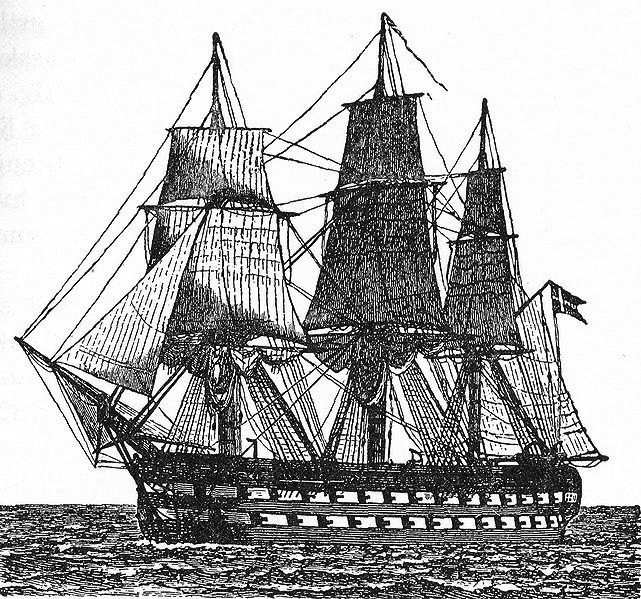
For this dive into two decades of Danish warships, we start with one of the most symbolic of its evolution and transformation to steam and armour:
The Danish ironclad Dannebrog was an armored frigate originally built as a classic 80-gun ship-of-the-line, planned in 1845, built by Andreas Schifter in 1848. She was launched in 1850but construction was suspended until she was redesigned and completed as a steam-powered ironclad, in the early 1860s. She had an uneventful career however, before being stricken in 1875. She became an accommodation ship until converted again as a target ship in 1896 and being sold and BU in 1897.
Development
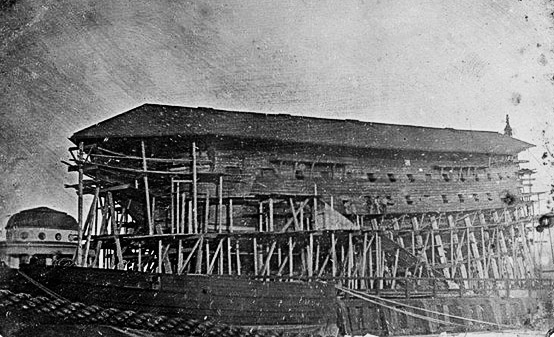
The ship of the line Dannebrog was Danish navy’s simultaneously last ship of the line, and after nine years of service (1853-1862) she was rebuilt in the Orlogsværftet dock, converted into an armored Frigate. This period was indeed marked by major changes in warships design. Since 1860, the building of armored ships on the British and French model, and when intel reports about the Battle of Hampton Roads in March 1862 arrived to the admiralty, these plans gained more momentum. Ut was however still needed to convince the parliament. The superiority of the armored ship was proven enough so that by April-May after much pressure, including the press, the Reichstag was urged to buy a monitor, judged cheaper than a sea going ironclad. Still, to possess this sea-going armour, it was decided to convert Dannebrog and the frigate Peder Skram, both into armored ships. It did not mattered if Dannebrog was a two-screw deckers, with a single gun battery, she had automatically this seemingly inferior rank.
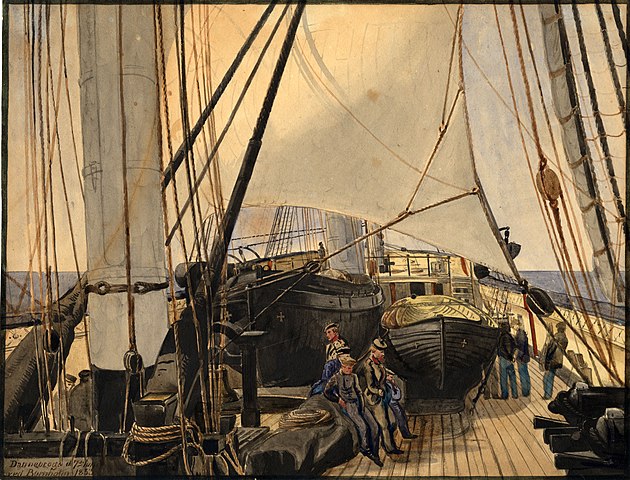
So in July 1862, Dannebrog was drydocked at Orlogsværftet for such conversion under Otto redrik Suenson. The top deck was removed, she was gutted down to the lower deck for a steam machinery to be installed, the deck was rebuilt above, the armor plates were fitted along the entire belt along the waterline. Dannebrog was completed by March 1864 and the crew barely had time to train before the war with a German-Austrian alliance.
Design of the class
Hull and general design
Dannebrog was originally 214 feet 10 inches (65.5 m) long between perpendiculars with a beam of 50 feet 10 inches (15.5 m) draft of 23 feet 3 inches (7.1 m) and a 3,057 long tons (3,106 t) displacement. As complete her crew went down to 350 officers and crewmen.
Powerplant
As completed, Dannebrog had a single steam engine and single four-bladed propeller. The engine was from Baumgarten & Burmeister, and was rated for 1,150 indicated horsepower (860 kW) total, for a top speed of 8 knots (15 km/h; 9.2 mph) up to 8,7 knots which was less than stellar. Radius of operation was however unlimited to her original three masts with barque rigging.

Armament
In 1848 as planned she was to have seventy-two 30-pounder Guns in her two main battery decks and ten 4-pounder Howitzers on her open deck.
From 1864 as rebuilt she had twelve 60-pounder 88 Cnt. Guns, all rifled and two 60-pounder 150 Cnt. Guns rifled on deck as well as three 18-poundser 40 Cnt. Guns also rifled on deck, on swivel mounts. After 1865: She was rearmed with six 60-pounder 150 Cnt. Guns, rifled, and eight 24-pounder 62 Cnt. Guns rifled.
I have no information about the rifled 60-pounder.
Protection
It was limited to the belt, with wrought-iron plates all along the waterline, 114 mm (4.5 in) and above another tray upon the battery deck, with the same thickness. There was no armor deck or conning tower.
⚙ Danneborg specifications as rebuilt |
|
| Displacement | 3,057 long tons (3,106 t) |
| Dimensions | 214 ft 10 in x 50 ft 10 in x 23 ft 3 in (65.5 m x 15.5 m x 7.1 m) |
| Propulsion | 1 shaft, HST, 4 boilers: 1,150 ihp (860 kW) |
| Speed | 8 knots (15 km/h; 9.2 mph) |
| Range | Barque-rigged: Unlimited |
| Armament | 16 × 60-pounder guns |
| Protection | Belt: 114 mm (4.5 in), Battery: 114 mm (4.5 in) |
| Crew | 350 |
Career of HDMS Dannebrog
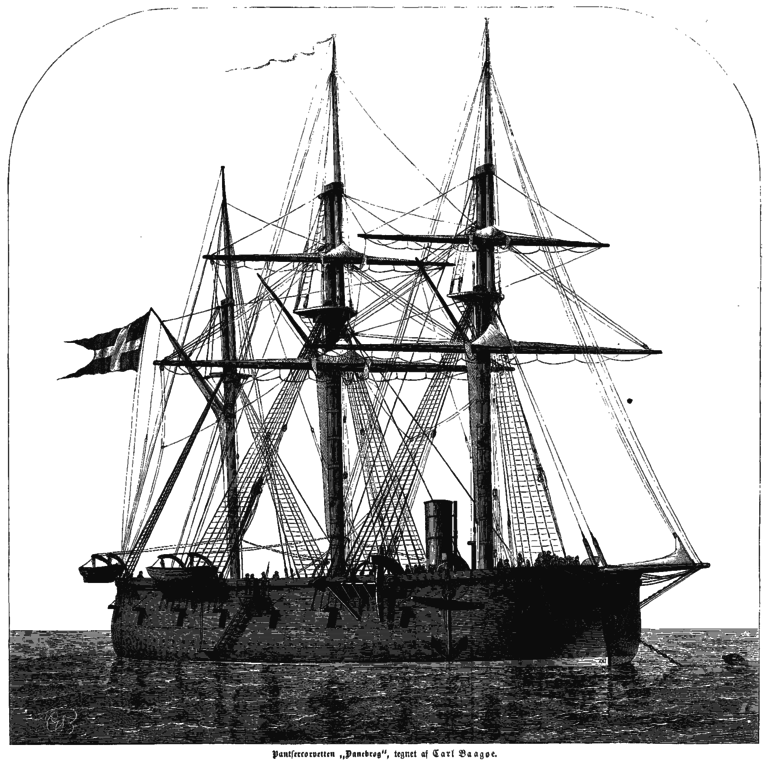
After the conversion, Dannebrog was sent to the squadron in the eastern part of the Baltic Sea. After the Battle of Heligoland, the navy suspected that Austria would send some of its armored ships to Danish waters, and in July-August Dannebrog was sent to the Kattegat together with the frigate Niels Juel to patrol. During this period, the Dannebrog was referred to as the “armored corvette”, a somewhat misleading title for one of the navy’s most powerful ships.
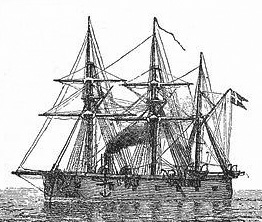 “Dannebrog” was of course the name of the Danish national flag, and after completion on 30 March 1864 she started triaks, but on 14 July 1864, she ran aground off Aarhus. She was refloated the next day and the rest of her early days are rather uneventful.
“Dannebrog” was of course the name of the Danish national flag, and after completion on 30 March 1864 she started triaks, but on 14 July 1864, she ran aground off Aarhus. She was refloated the next day and the rest of her early days are rather uneventful.
In 1865, the designation was changed to armored frigate. Dannebrog was equipped again in 1870, when it was included in the summer squadron. The ship retired from the navy in 1875, and had both armour, machinery and artillery removed. The armor did not go to waste, because part of it was used in Copenhagen’s fortifications. Dannebrog was then a barracks ship until 1894, then it was used as a floating launch pad, and finally broken up in 1897-98.
Dannebrog’s cannons were recast in 1881-1882 into a statue by Niels Ebbesen, which can be seen on Rådhustorvet in Randers.
She was converted into an accommodation ship in 1875 and served that way until being used as a target ship on 30 May 1896 and being broken up in 1897.
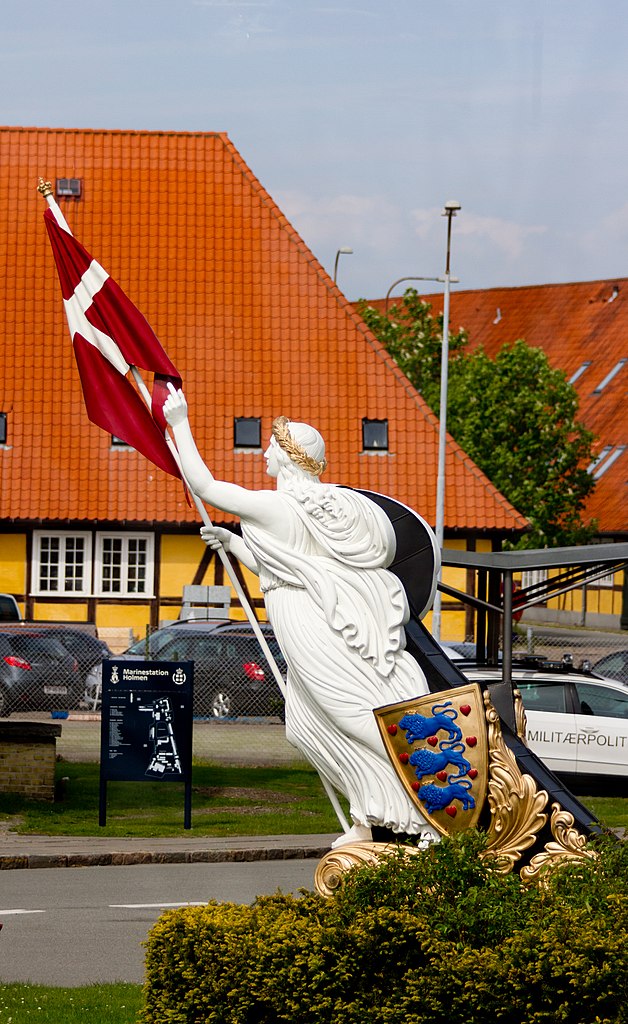
The figurehead of Dannebrog on display in Copenhagen
Her figurehead was preserved and is now on display at the entrance to Marinestation København, Nyholm, Copenhagen, previously on Frederiksholm island.
Read More/Src
Books
R. Steen Steensen, Vore panserskibe, (Marinehistorisk Selskab, 1968)
Conway’s all the world’s fighting ships 1860-1905
Links
navalhistory.dk/
milhist.dk/ dannebrogs-endeligt/
orlogsbasen.dk/Skibdk.htm
da.wikipedia.org Dannebrog_(1850)

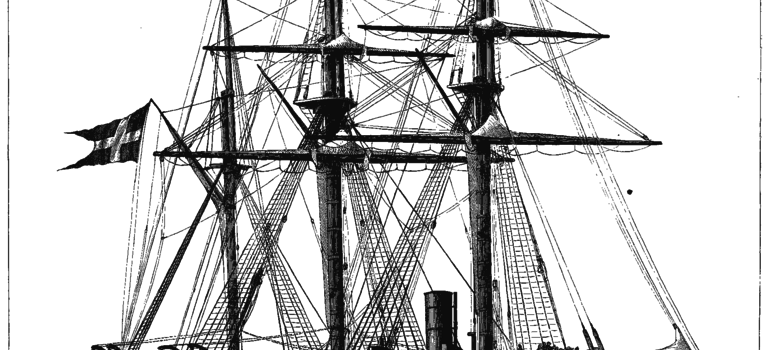

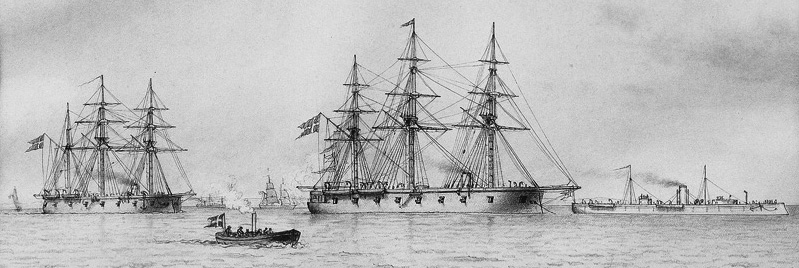
 Latest Facebook Entry -
Latest Facebook Entry -  X(Tweeter) Naval Encyclopedia's deck archive
X(Tweeter) Naval Encyclopedia's deck archive Instagram (@navalencyc)
Instagram (@navalencyc)





 French Navy
French Navy Royal Navy
Royal Navy Russian Navy
Russian Navy Armada Espanola
Armada Espanola Austrian Navy
Austrian Navy K.u.K. Kriegsmarine
K.u.K. Kriegsmarine Dansk Marine
Dansk Marine Nautiko Hellenon
Nautiko Hellenon Koninklije Marine 1870
Koninklije Marine 1870 Marinha do Brasil
Marinha do Brasil Osmanlı Donanması
Osmanlı Donanması Marina Do Peru
Marina Do Peru Marinha do Portugal
Marinha do Portugal Regia Marina 1870
Regia Marina 1870 Nihhon Kaigun 1870
Nihhon Kaigun 1870 Preußische Marine 1870
Preußische Marine 1870 Russkiy Flot 1870
Russkiy Flot 1870 Svenska marinen
Svenska marinen Søværnet
Søværnet Union Navy
Union Navy Confederate Navy
Confederate Navy Armada de Argentina
Armada de Argentina Imperial Chinese Navy
Imperial Chinese Navy Marinha do Portugal
Marinha do Portugal Mexico
Mexico Kaiserliche Marine
Kaiserliche Marine 1898 US Navy
1898 US Navy Sovietskiy Flot
Sovietskiy Flot Royal Canadian Navy
Royal Canadian Navy Royal Australian Navy
Royal Australian Navy RNZN Fleet
RNZN Fleet Chinese Navy 1937
Chinese Navy 1937 Kriegsmarine
Kriegsmarine Chilean Navy
Chilean Navy Danish Navy
Danish Navy Finnish Navy
Finnish Navy Hellenic Navy
Hellenic Navy Polish Navy
Polish Navy Romanian Navy
Romanian Navy Turkish Navy
Turkish Navy Royal Yugoslav Navy
Royal Yugoslav Navy Royal Thai Navy
Royal Thai Navy Minor Navies
Minor Navies Albania
Albania Austria
Austria Belgium
Belgium Columbia
Columbia Costa Rica
Costa Rica Cuba
Cuba Czechoslovakia
Czechoslovakia Dominican Republic
Dominican Republic Haiti
Haiti Hungary
Hungary Honduras
Honduras Estonia
Estonia Iceland
Iceland Eire
Eire Equador
Equador Iran
Iran Iraq
Iraq Latvia
Latvia Liberia
Liberia Lithuania
Lithuania Mandchukuo
Mandchukuo Morocco
Morocco Nicaragua
Nicaragua Persia
Persia San Salvador
San Salvador Sarawak
Sarawak Uruguay
Uruguay Venezuela
Venezuela Zanzibar
Zanzibar Warsaw Pact Navies
Warsaw Pact Navies Bulgaria
Bulgaria Hungary
Hungary

 Bundesmarine
Bundesmarine Dutch Navy
Dutch Navy Hellenic Navy
Hellenic Navy Marina Militare
Marina Militare Yugoslav Navy
Yugoslav Navy Chinese Navy
Chinese Navy Indian Navy
Indian Navy Indonesian Navy
Indonesian Navy JMSDF
JMSDF North Korean Navy
North Korean Navy Pakistani Navy
Pakistani Navy Philippines Navy
Philippines Navy ROKN
ROKN Rep. of Singapore Navy
Rep. of Singapore Navy Taiwanese Navy
Taiwanese Navy IDF Navy
IDF Navy Saudi Navy
Saudi Navy Royal New Zealand Navy
Royal New Zealand Navy Egyptian Navy
Egyptian Navy South African Navy
South African Navy






























 Ukrainian Navy
Ukrainian Navy dbodesign
dbodesign